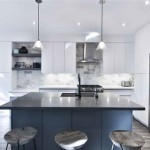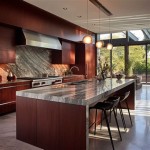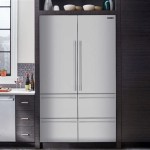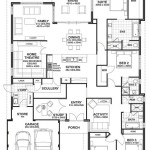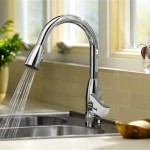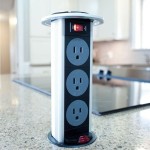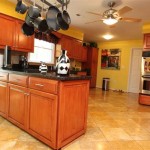Maximizing Space In A Small Kitchen
Small kitchens present unique challenges in terms of functionality and storage. Careful planning and implementation of space-saving strategies are crucial to creating a kitchen that is both efficient and aesthetically pleasing. This article will explore various techniques and ideas for maximizing space in a small kitchen, focusing on optimizing storage, utilizing vertical space, and choosing multifunctional appliances and furniture.
Embracing Vertical Storage Solutions
One of the most effective strategies for maximizing space in a small kitchen is to fully utilize vertical space. Walls often go underutilized, representing a significant opportunity for storage expansion. This can be achieved through a variety of methods, including installing taller cabinets, implementing open shelving, and utilizing wall-mounted organizers.
Tall cabinets that extend almost to the ceiling are an excellent way to increase storage capacity without taking up additional floor space. These cabinets can be used to store infrequently used items, such as seasonal cookware or bulk food supplies, freeing up space in lower cabinets for everyday essentials. Consider installing adjustable shelves within these cabinets to accommodate items of different sizes and maximize space utilization. Optimize internal organization by using shelf dividers and risers to further refine the storage process.
Open shelving offers a visually appealing and accessible storage solution. Unlike closed cabinets, open shelves allow you to easily see and reach items, reducing the need to rummage through cabinets to find what you are looking for. Shelving can be used to display frequently used dishes, glassware, cookbooks, or decorative items. Consider varying the spacing between shelves to accommodate items of different heights. To maintain a clean and organized look, consider grouping similar items together and using decorative containers to store smaller items.
Wall-mounted organizers are versatile and adaptable to a wide range of storage needs. These organizers can include magnetic knife strips, spice racks, utensil holders, and pot racks. By mounting these items on the wall, you can free up valuable counter and drawer space. Magnetic knife strips are an especially efficient way to store knives safely and within easy reach, while spice racks can keep your spices organized and accessible during cooking. Consider using adhesive hooks to hang lightweight items like kitchen towels or pot holders, further optimizing the use of wall space.
Optimizing Cabinet and Drawer Organization
Efficient organization within cabinets and drawers is essential for maximizing usable storage space in a small kitchen. Implementing internal organizers, such as pull-out shelves, drawer dividers, and tiered racks, can significantly improve accessibility and reduce clutter. Proper planning and strategic placement of these organizers can transform cramped and disorganized spaces into efficient and user-friendly storage areas.
Pull-out shelves, also known as roll-out shelves, are an invaluable addition to any kitchen with deep cabinets. These shelves slide out, allowing easy access to items stored at the back of the cabinet. This eliminates the need to reach deep into the cabinet, which can be particularly difficult for individuals with limited mobility. Pull-out shelves are ideal for storing pots, pans, food containers, and other bulky items. Consider installing pull-out shelves with soft-close mechanisms to prevent slamming and reduce wear and tear on the cabinets.
Drawer dividers are essential for keeping drawers organized and preventing items from shifting around. These dividers can be used to separate utensils, cutlery, cooking tools, and other items. Adjustable drawer dividers offer flexibility in customizing the layout to suit individual needs. Alternatively, you can use pre-made drawer organizers to create designated spaces for specific items. Consider using shallow drawers for frequently used items, such as spices or kitchen gadgets, and deeper drawers for larger items, such as pots and pans.
Tiered racks are an excellent way to maximize vertical space within cabinets and drawers. These racks create multiple levels of storage, allowing you to store more items in the same amount of space. Tiered racks are particularly useful for storing plates, bowls, and other dishes. They can also be used to store spices, cans, and other pantry items. Consider using tiered racks with non-slip surfaces to prevent items from sliding around.
Choosing Multi-Functional Appliances and Furniture
In a small kitchen, every inch of space is valuable. Choosing appliances and furniture that serve multiple purposes can significantly reduce clutter and free up valuable countertop and storage space. Opting for appliances that combine several functions or furniture that can be easily folded away or stored when not in use can be a game-changer in optimizing a small kitchen layout.
Multi-functional appliances can significantly reduce the number of individual appliances needed in a small kitchen. Consider a convection microwave oven that can function as both a microwave and a convection oven, eliminating the need for a separate oven. Another option is an induction cooktop with a built-in range hood, which combines the cooking surface and ventilation system into a single unit. A food processor with multiple attachments can perform various tasks, such as chopping, slicing, shredding, and kneading, reducing the need for separate appliances. When selecting multi-functional appliances, consider the quality, performance, and ease of use of each function to ensure that the appliance meets your specific needs.
Foldable or collapsible furniture is another space-saving solution for small kitchens. A folding dining table can be easily stored away when not in use, freeing up floor space. Folding chairs can also be stored compactly when not needed. A kitchen island with wheels can be moved around the kitchen as needed and then stored against a wall when not in use. Consider a kitchen cart with a drop-leaf countertop to provide additional workspace when needed and fold down for storage when not in use. When selecting foldable or collapsible furniture, consider the durability, stability, and ease of use of the folding mechanism.
Built-in appliances offer a streamlined and space-saving solution for small kitchens. A built-in refrigerator, oven, and dishwasher can be integrated seamlessly into the cabinetry, creating a clean and uncluttered look. Built-in appliances also eliminate the gaps between appliances and cabinets, preventing crumbs and debris from accumulating. Consider a built-in microwave oven or a built-in coffee maker to free up valuable countertop space. When selecting built-in appliances, consider the dimensions, installation requirements, and compatibility with your existing cabinetry.
Optimizing Lighting and Color Schemes
Proper lighting and well-chosen color schemes can significantly impact the perceived size and spaciousness of a small kitchen. By strategically incorporating bright and natural lighting and selecting light and airy colors, you can create a kitchen that feels larger and more inviting. Moreover, effective lighting can enhance functionality, making it easier to see and work in the kitchen.
Maximize natural light by keeping windows clean and unobstructed. Avoid heavy curtains or blinds that block natural light. Consider using sheer curtains or blinds that allow light to filter through while still providing privacy. If possible, add or enlarge windows to increase the amount of natural light entering the kitchen. Strategically placed mirrors can also reflect light and create the illusion of more space. Position mirrors opposite windows to bounce light around the room.
Incorporate multiple layers of artificial lighting to create a well-lit and functional kitchen. Overhead lighting, such as recessed lighting or pendant lights, provides general illumination for the entire room. Task lighting, such as under-cabinet lighting or spotlights, provides focused light for specific work areas, such as countertops and stovetops. Accent lighting, such as decorative sconces or LED strip lighting, adds visual interest and ambiance to the kitchen. Consider using dimmers to adjust the brightness of the lights to suit different tasks and moods.
Light and neutral color schemes can make a small kitchen feel larger and more open. White, cream, beige, and light gray are popular choices for kitchen walls, cabinets, and countertops. These colors reflect light and create a sense of spaciousness. Avoid dark or bold colors, which can make a small kitchen feel cramped and enclosed. If you want to add color, consider using it sparingly in accents, such as accessories, textiles, or a backsplash. A monochromatic color scheme, using different shades of the same color, can also create a cohesive and spacious look.
Decluttering and Minimalist Design
Adopting a minimalist design approach and consistently decluttering the kitchen can dramatically improve the overall functionality and aesthetic appeal of a small kitchen. A clutter-free environment not only maximizes usable space but also creates a sense of calm and order, making the kitchen a more enjoyable place to be.
Regularly decluttering your kitchen is essential for maintaining a functional and organized space. Go through your cabinets, drawers, and countertops and remove any items that you no longer use or need. Donate or discard expired food, broken appliances, and duplicate items. Consider implementing a "one in, one out" rule, where you get rid of an item whenever you acquire a new one. This helps prevent clutter from accumulating over time. Create designated storage areas for different types of items and ensure that everything has a place. Label containers and shelves to make it easier to find what you are looking for.
A minimalist design approach focuses on simplicity, functionality, and a reduced number of items. Opt for clean lines, simple shapes, and a neutral color palette to create a sense of spaciousness. Avoid overly ornate details or cluttered decorations. Choose durable and functional materials that are easy to clean and maintain. Consider using open shelving sparingly, as it can easily become cluttered. Instead, opt for closed cabinets to conceal items and create a more streamlined look. Minimize the number of countertop appliances and accessories, keeping only the essentials within reach.
Streamlining your countertop space is crucial for creating a functional and aesthetically pleasing small kitchen. Limit the number of items on your countertops to only the essentials, such as a coffee maker, toaster, or knife block. Store small appliances in cabinets or drawers when not in use. Use countertop organizers to keep essential items tidy and within reach. Consider using a cutting board that fits over the sink to provide extra counter space when needed. Regularly wipe down countertops to keep them clean and clutter-free.

19 Design Tricks To Maximize A Small Kitchen
:max_bytes(150000):strip_icc()/1894-house-in-holbaek-kitchen-via-smallspaces.about.com-56a888ad3df78cf7729e9ad6.jpg?strip=all)
13 Space Making S For Small Kitchens

19 Design Tricks To Maximize A Small Kitchen

6 Ways To Maximize The Space In A Small Kitchen

7 Ways To Make The Most Of A Tiny Kitchen Space Eatwell101

7 Tips To Maximize The Space Of Kitchen Oppein

5 Ways To Maximize Space In A Small Kitchen

10 Small Kitchen Design Ideas To Maximize Space

7 Savvy Ideas To Maximize Your Small Kitchen Remodel

Space Saving Ideas For A Small Kitchen Sunrise Home Inspection Llc


